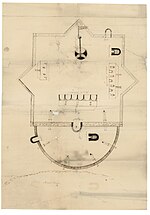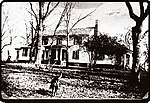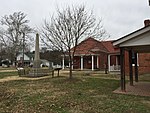Upper Weyanoke
Houses completed in 1859Houses in Charles City County, VirginiaHouses on the National Register of Historic Places in VirginiaJames River plantationsNational Register of Historic Places in Charles City County, Virginia ... and 2 more
Plantation houses in VirginiaVirginia Peninsula Registered Historic Place stubs

Upper Weyanoke is a historic plantation house close to Charles City, Charles City County, Virginia. The property contains a one-and-a-half-story cottage built in about 1815, and a larger two-story Greek Revival style residence erected in 1858–59. The cottage was probably built by John Minge as a two-room dependency to a now-vanished main dwelling. The main house was built for Robert Douthat, and is a two-story brick dwelling with a side-hall plan typically utilized in urban homes, rather than rural plantation houses.The house was added to the National Register of Historic Places in 1980.
Excerpt from the Wikipedia article Upper Weyanoke (License: CC BY-SA 3.0, Authors, Images).Upper Weyanoke
Sandy Fields Road,
Geographical coordinates (GPS) Address Nearby Places Show on map
Geographical coordinates (GPS)
| Latitude | Longitude |
|---|---|
| N 37.298333333333 ° | E -77.073611111111 ° |
Address
Sandy Fields Road
Sandy Fields Road
23030
Virginia, United States
Open on Google Maps








